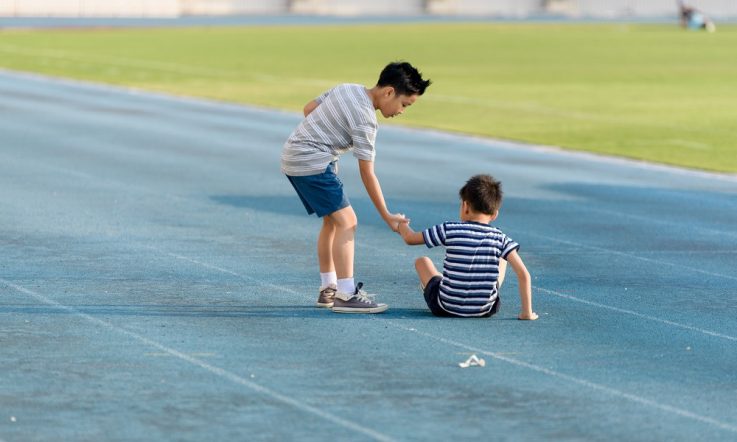Dr Sarah Tillott is a lecturer at the University of Wollongong and CEO of School for Living, a resilience-based organisation that creates resources targeted at children aged three to eight years. Over a three-part series for Teachers, Tillott and colleagues will be exploring resilience theory, the adaptive and maladaptive traits of resilience in children, and the practical application of resilience in the classroom. In this first instalment, Tillott discusses stress and its effect on the brain, and the importance of developing resilience skills from an early age.
Encouraging the attributes of resilience in children as part of an early intervention and prevention approach is well supported by the literature, to not only safeguard against the effects of adversity and mental illness, but also enable individuals to acquire the attributes to adapt and thrive in challenging circumstances (Masten & Tellegen, 2012; Rutter, 2008; Ungar, 2006)
Unfortunately, children with high exposure to risk and low exposure to support are vulnerable to poor mental health and academic outcomes (Cahill et al., 2014).
Within the last decade, the Australian Institute for Health and Wellbeing (AIHW) reported that 10 per cent of children aged four to 12 years were classified as having abnormal social and emotional wellbeing, and almost one in seven children and adolescents aged four to 17 years (13.9 per cent) were assessed as having a mental health disorder (AIHW, 2017). This suggests initiatives need to be implemented in the early years.
The context of resilience
There are several definitions of resilience in the context of exposure to challenging circumstances. One of the most recent explains it as a multifactorial, multidimensional facet that incorporates the social, environment, and cultural conditioning of the individual.
Resilience is considered a protective tool that supports individuals when they are faced with challenges, with the aim being to use support strategies to not only cope, but potentially grow through the process.
However, data suggest access to this knowledge on how to implement the interpersonal aspects of resilience in difficult or challenging situations requires much more attention. For example:
- A quarter of children in primary school are bullied on the playground, causing significant physiological, psychological and social challenges (peak age nine years old) (Cross et al., 2012);
- Sixty per cent of children entering schools have had very little to no resilience-based training, compromising conflict resolution and problem solving capabilities (Tillott, 2019);
- One in seven children aged 0-14 have reported a preventable mental health issue (AIHW, 2017); and,
- An increase in preventable harm cases for children have been reported in New South Wales which are attributed to excessive substance use or poor parental experience and practice. (NSW Government, 2019).
Developing resilience skills
Being exposed to adversity is inevitable. How we manage and adapt as a response is what can make the difference between poor outcomes, or outcomes that signify growth from the experience. As suggested by Ungar and Hadfield (2019), resilience is developed through social, cultural, mental and physical factors. All facets become important when supporting the growth and development of a child.
My doctoral study looked at the cognitive constructs that form interpersonal development. This does not discount the need for a child's social and environmental conditioning, but is merely one thread that can support the development of resilience. My study found the development of interpersonal resilience skills is not well understood and requires a significant investment in community resilience-based training, inclusive of teachers, parents, carers and sporting forums (Tillott, 2019).
Grotberg (1997) highlights the need for children to have several cognitive processes in place – or ‘interpersonal skills' – which enable them to manage their emotions and resolve conflicts. These are referred to as executive skills that support metacognition. The earlier the child experiences stress without supportive platforms in place, the more likely that this stress will compromise the cognitive platforms on which the mental constructs of resilience are developed.
This experience of early adversity can result as a trauma in the brain, thus compromising the ability for the child to use the executive skills that support the development of cognitive resilience.
Stress and the effects on the brain
The development of resilience (from an interpersonal aspect) relies upon children having access to the pre-frontal cortex, which enables access to the executive functions (metacognition) that support the development of resilience.
When children experience episodes of severe stress early in life it can cause a dysregulation of the hypothalamic pituitary-adrenal function, compromising the executive functions of the brain responsible for effective problem solving, decision-making and memory function (core executive functional skills), that enable a child to assess their environment for problem solving purposes.
In turn, this creates hyper-vigilance in the child, an inability to sleep and a decreased capacity to concentrate (Nicoll, 2014). Those executive functions that support the development of resilience can be significantly compromised, making it very difficult for a child to recover or apply resilience-based skills without expert intervention. The child becomes predisposed to forming maladaptive ways of coping and may acquire learning difficulties, mental health disorders and personal/behavioural adjustment problems, which can affect adult life.
Understanding the risks and/or impact that early trauma and adversity can have on a developing brain can facilitate the intervention of techniques and a modification in environment that a child may need to transform maladaptive ways of coping to a more adaptive, resilience-supporting response (Garmezy, 1991; Skinner & Zimmer-Gembeck, 2016).
Resilience, education and mental wellbeing
Research indicates school-based mental health, resilience and social and emotional learning initiatives, in Australia and internationally, can significantly improve the health, wellbeing and psychosocial skills of children – particularly for those who may have experienced early adversity. This can also lead to improved learning and academic outcomes (Greenberg, 2010; Nicoll, 2014).
To support the development of resilience-based learning in children, more education and training on interpersonal adaptive and maladaptive responses that support and compromise the development of resilience is imperative. Furthermore, teaching training and confidence building are required to implement these skills in the early years.
Stay tuned: In part two, Dr Sarah Tillott will discuss the adaptive and maladaptive traits of resilience.
References
Australian Institute of Health and Welfare (AIHW) (2017). Australia's health 2016. Australia's health series no. 15. Cat. no. AUS 199.
Cahill, H., Beadle, S., & Farrelly, R. (2014). Building resilience in children and young people: a literature review for the Department of Education and Early Childhood Development (DEECD). Melbourne Graduate School of Education Youth Research Centre.
Cross, D. S., Shaw, T. M., Epstein, M., Monks, H. E., Dooley, J. J., & Hearn, L. A. (2012). Cyberbullying in Australia: Is school context related to cyberbullying behaviour? In Q. Li, D. Cross, & P. K. Smith (Eds.), Cyberbullying in the global playground: Research from international perspectives (pp. 75–98). Wiley-Blackwell.
Garmezy, N. (1991). Resilience in children's adaptation to negative life events and stressed environments. Pediatric Annals, 20(9), 459-466.
Greenberg, M. T. (2010). School‐based prevention: current status and future challenges. Effective Education, 2(1), 27-52. http://dx.doi.org/10.1080 /19415531003616862
Grotberg, E. H. (1997). The International Resilience Project: Findings from the research and the effectiveness of interventions. In B. Bain et al. (Eds.), Psychology and education in the 21st Century: Proceedings of the 54th Annual Convention of the International Council of Psychologists. IC Press.
Masten, A. S., & Tellegen, A. (2012). Resilience in developmental psychopathology: Contributions of the project competence longitudinal study. Development and psychopathology, 24(2), 345-361. http://dx.doi.org/10.1017/s095457941200003x
Nicoll, W. G. (2014). Developing transformative schools: A resilience- focused paradigm for education. International Journal of Emotional Education, 6(1), 47–65.
NSW Government. (2019). Premier's Priorities 2019: Protecting our most vulnerable children. https://www.nsw.gov.au/premiers-priorities/protecting-our-most-vulnerable-children
Rutter, M. (2008). Institutional effects on children: Design issues and substantive findings. Monographs of the Society for Research in Child Development, 73(3), 271–278. http://dx.doi.org/10.1111/j.1540-5834.2008.00497.x
Skinner, E. A., & Zimmer-Gembeck, M. (2016). The development of coping: Stress, neurophysiology, social relationships and resilience during childhood and adolescence. Springer International.
Tillott, S. (2019) ‘An investigation into the elements of resilience that children identify from reading Game ON, Thesis submitted University of Wollongong https://ro.uow.edu.au/theses1/547/
Ungar, M. (2006). Resilience across cultures. British Journal of Social Work, 38(2), 218–235. http://dx.doi.org/10.1093/bjsw/bcl343
Ungar, M., & Hadfield, K. (2019). The differential impact of environment and resilience on youth outcomes. Canadian Journal of Behavioural Science / Revue canadienne des sciences du comportement, 51(2), 135–146. https://doi.org/10.1037/cbs0000128
Sarah Tillott says: ‘Being exposed to adversity is inevitable. How we manage and adapt as a response is what can make the difference between poor outcomes, or outcomes that signify growth from the experience.’
As a teacher, how do you help to build resilience in the students you teach, to help them when they are faced with adversity? Have you found any strategies to be particularly helpful?



